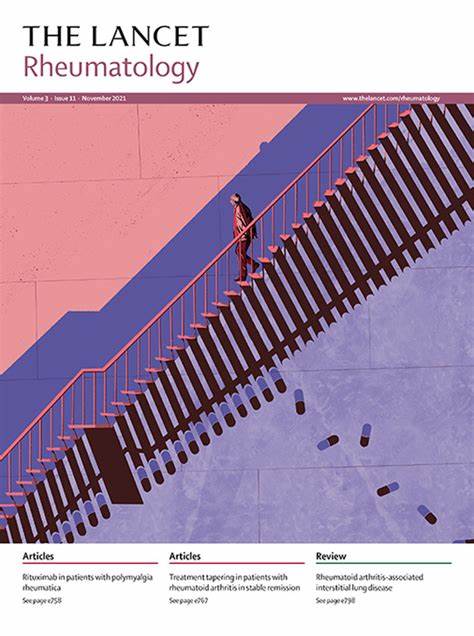Detection of decline in pulmonary function in patients with systemic sclerosis-associated interstitial lung disease using home monitoring in the Netherlands (DecreaSSc): a prospective, observational study
IF 15
1区 医学
Q1 RHEUMATOLOGY
引用次数: 0
Abstract
Background
In patients with systemic sclerosis, interstitial lung disease (ILD) is the leading cause of mortality. Early detection of progressive ILD associated with systemic sclerosis is warranted for timely adjustment of management strategies and improved prognosis. We aimed to investigate the validity of home spirometry to detect a decline in pulmonary function in patients with systemic sclerosis-associated ILD.
Methods
DecreaSSc was a prospective, observational study done in two tertiary referral centres in the Netherlands. Eligible patients were aged 18 years or older, fulfilled the American College of Rheumatology–European Alliance of Associations for Rheumatology criteria for systemic sclerosis, had a disease duration from first non-Raynaud phenomenon symptom of 5 years or less, had high-resolution CT-confirmed diagnosis of ILD, and had a maximum immunosuppressive treatment duration of 8 weeks at baseline. Patients took weekly home spirometry measurements using a handheld spirometer for 1 year. At baseline and at semi-annual study visits, patients pulmonary function testing was done in the hospital and patients completed questionnaires on patient-reported outcome measurements. The primary outcome was the κ agreement between home and hospital measurements after 1 year to detect a decline in force vital capacity (FVC) of 5% or more, estimated using separate linear regression analyses for home-based and hospital-based FVC% predicted in individual patients. The sensitivity and specificity of home spirometry to detect an absolute decline in FVC% predicted of 5% or more was assessed using the hospital pulmonary function test as the gold standard. The longitudinal correlation between hospital and home measurements was assessed with regression analysis, whereas the cross-sectional correlation was assessed with the intraclass coefficient. People with lived experience were involved at several stages of the study.
Findings
Between Jan 26, 2021, and Feb 27, 2023, 43 patients were enrolled, 35 of whom completed 6 months of follow-up and 31 of whom completed 12 months of follow-up. The last follow-up visit took place on March 28, 2024. 20 (57%) of patients were women and 15 (43%) were men; 32 (91%) were White. Mean age was 57·7 years (SD 10·7). The agreement between hospital and home measurements had a κ value of 0·40 (95% CI 0·01–0·79). The sensitivity of home spirometry to detect a decline in FVC% predicted of 5% or more was 60% (95% CI 44–76) and specificity was 87% (75–98). Regression analysis showed that the course of pulmonary function was not different between hospital and home assessment as the interaction term was not significant (–0·0003 [95% CI –0·0006 to 0·000008]; p=0·057) with a longitudinal correlation of 0·55 (95% CI 0·26–0·74; p=0·0070). The intraclass coefficient between both measurements was 0·85 (95% CI 0·73–0·92; p<0·0001) at baseline, 0·84 (0·71–0·92; p<0·0001) at 6 months, and 0·72 (0·50–0·86; p<0·0001) at 12 months.
Interpretation
Home spirometry has the potential to detect a decline in pulmonary function in patients with systemic sclerosis-associated ILD earlier when used in addition to regular health care management. Future research could reveal whether home spirometry can contribute to improved outcomes of patients with systemic sclerosis-associated ILD.
Funding
Galapagos and Boehringer Ingelheim.
荷兰利用家庭监测检测系统性硬化症相关间质性肺病患者肺功能下降的情况(DecreaSSc):一项前瞻性观察研究。
背景:在系统性硬化症患者中,间质性肺病(ILD)是导致死亡的主要原因。为了及时调整治疗策略和改善预后,有必要及早发现与系统性硬化症相关的进行性间质性肺病。我们旨在研究家庭肺活量测定法检测系统性硬化症相关 ILD 患者肺功能下降的有效性:DecreaSSc是一项前瞻性观察研究,在荷兰的两个三级转诊中心进行。符合条件的患者年龄在 18 岁或以上,符合美国风湿病学会-欧洲风湿病学协会联盟的系统性硬化症标准,自首次出现非雷诺现象症状起病程在 5 年或以下,经高分辨率 CT 确诊为 ILD,基线免疫抑制治疗时间最长为 8 周。患者每周使用手持式肺活量计进行家庭肺活量测量,为期一年。在基线和半年一次的研究回访中,患者在医院进行肺功能检测,并填写患者报告结果测量问卷。研究的主要结果是一年后家庭和医院测量结果的κ吻合度,以检测患者体力活动能力(FVC)是否下降了5%或更多,该结果是通过对单个患者的家庭和医院预测FVC%进行单独的线性回归分析来估算的。以医院肺功能测试作为金标准,评估了家庭肺活量测定检测 FVC% 预测值绝对值下降 5% 或以上的灵敏度和特异性。医院和家庭测量结果之间的纵向相关性通过回归分析进行评估,而横向相关性则通过类内系数进行评估。有生活经验的人参与了研究的多个阶段:2021年1月26日至2023年2月27日,43名患者入组,其中35人完成了6个月的随访,31人完成了12个月的随访。最后一次随访于 2024 年 3 月 28 日进行。20名患者(57%)为女性,15名患者(43%)为男性;32名患者(91%)为白人。平均年龄为 57-7 岁(SD 10-7)。医院和家庭测量结果的κ值为0-40(95% CI 0-01-0-79)。家庭肺活量测量对预测 FVC% 下降 5% 或以上的检测灵敏度为 60% (95% CI 44-76),特异性为 87% (75-98)。回归分析表明,医院和家庭评估的肺功能变化过程并无不同,交互项不显著(-0-0003 [95% CI -0-0006 to 0-000008];p=0-057),纵向相关性为 0-55 (95% CI 0-26-0-74; p=0-0070)。两种测量值之间的类内系数为 0-85 (95% CI 0-73-0-92; p解释:家庭肺活量测量有可能在常规医疗管理的基础上更早地发现系统性硬化症相关 ILD 患者肺功能的下降。未来的研究将揭示家庭肺活量测定是否有助于改善系统性硬化症相关性 ILD 患者的预后:资助:Galapagos 和 Boehringer Ingelheim。
本文章由计算机程序翻译,如有差异,请以英文原文为准。
求助全文
约1分钟内获得全文
求助全文
来源期刊

Lancet Rheumatology
RHEUMATOLOGY-
CiteScore
34.70
自引率
3.10%
发文量
279
期刊介绍:
The Lancet Rheumatology, an independent journal, is dedicated to publishing content relevant to rheumatology specialists worldwide. It focuses on studies that advance clinical practice, challenge existing norms, and advocate for changes in health policy. The journal covers clinical research, particularly clinical trials, expert reviews, and thought-provoking commentary on the diagnosis, classification, management, and prevention of rheumatic diseases, including arthritis, musculoskeletal disorders, connective tissue diseases, and immune system disorders. Additionally, it publishes high-quality translational studies supported by robust clinical data, prioritizing those that identify potential new therapeutic targets, advance precision medicine efforts, or directly contribute to future clinical trials.
With its strong clinical orientation, The Lancet Rheumatology serves as an independent voice for the rheumatology community, advocating strongly for the enhancement of patients' lives affected by rheumatic diseases worldwide.
 求助内容:
求助内容: 应助结果提醒方式:
应助结果提醒方式:


